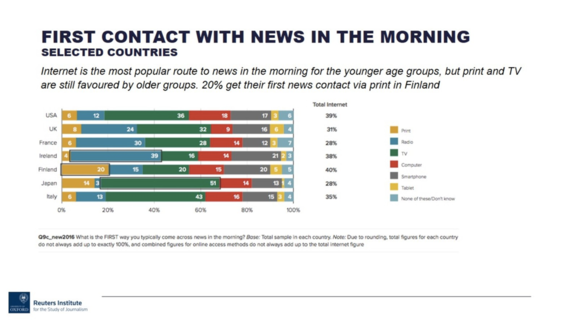During the past decade, digital technology has dramatically changed the way we consume - and create - news and information. This pace - as discussed last week at the annual Global Editors Network conference (GEN Summit 2016) - shows no sign of abating.
Over the course of 2.5 days, the theme of digital disruption was firmly front and centre; as successive panels and presentations highlighted the impact tech innovation will have on our evolving news habits.
From that perspective, here are seven emerging tech trends which caught my eye.
1.Social media is increasingly our portal to news
According to research from the Reuters Institute for the Study of Journalism at the University of Oxford, social media is used each week by more than half (51%) of online news consumers to find, discuss and share, news content.
Their fifth Digital News Report, using data from over 50,000 online news users in 26 countries, also revealed that among audiences aged 18-24 social media is now their preferred news source; beating TV (28% vs 24%) for the first time.
Globally, the study found, 12% said social media is their main news source.
2.New morning routines
The idea of starting your day by reading a newspaper, is an increasingly antiquated concept. Just 8% of news audiences in the UK do this, dropping to 6% in the US.
In both countries, online services - social media, apps and news websites - are the first port of call for most news consumers, ahead of both TV and Radio, as well as newspapers.

3.Chat apps are the next evolution in social media
Globally, services like WhatsApp and WeChat already have huge user bases, whilst Snapchat has overtaken Twitter in terms of daily users. Snapchatters watch 10 billion (yes, billion) videos a day.
News organisations are alert to this shift in behaviour. As a result, companies like the BBC, Wall Street Journal and BuzzFeed are experimenting with platforms such as Snapchat, Viber, Line and Facebook Messenger.
We're going to get (and share) a lot more of our news and information from these types of services in the future.
4.Chat Bots are creating new conversation tools
A number of US publishers are using quizzes, chat bots and more informal ways of delivering news and current affairs to audiences.
This includes interactive services, such as Quartz's chat-like news app, the Washington Post's Kik bot and TrumpChat, a bot from Mic which delivers interactive news snippets whilst mimicking Donald Trump's Twitter voice.
These services are fun, conversational and offer a means to potentially engage audiences in new and innovative ways.

Image: via the Medium page of the product team at Mic.com
5.Robots are becoming reporters
The Associated Press (AP) announced in January 2015 that it "is now automatically generating more than 3,000 stories about U.S. corporate earnings each quarter." This represents "a tenfold increase over what AP reporters and editors created previously."
Automated, or robo-journalism, won't work for everything, but it's currently being used on relatively formulaic journalistic output like business/earnings reporting and sport. Meanwhile, the Los Angeles Times has used its Quakebot tool to report on earthquakes in the region.
Evidence suggests that unless they're told material has been produced by a robot, most audiences cannot spot the difference.
6.360° content is giving us the full picture
Facebook users may have noticed that you can now view 360° images on the social network. They - and YouTube - both introduced 360° video last year.
These more immersive visual forms offer new perspectives on news stories and other media content; and are only going to become more prevalent.

Image: via Facebook
7.Virtual Reality is the next visual frontier
Although still early days for this technology, this is another platform that content creators are experimenting with. In the past year we've seen VR efforts from the New York Times, the BBC and others.
At the GEN Summit I had the opportunity to view a video - produced by the SMART News Agency - which showed the devastating impact of Syria's civil war on Aleppo in a way that 2D photographs and video arguably cannot.
The Future
Any discussion on where technology might take us tends to quote William Gibson, who famously wrote: "the future is already here, it's just not very evenly distributed yet."
That sentiment was certainly in evidence last week.
These seven tech trends - along with others such as faster mobile networks and more powerful mobile devices - are already beginning to reshape journalism and news media.
Their impact will only increase as these technologies, and the behaviours associated with them, become more mainstream. The digital news revolution has only just begun.
